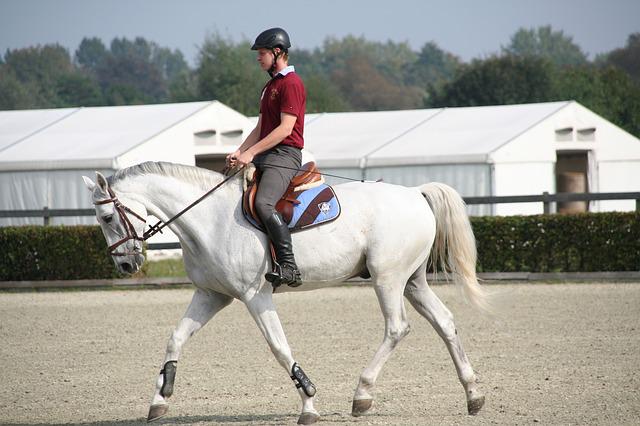Horse riding is an exhilarating sport that combines grace, strength and harmony between rider and horse. Whether you’re a beginner or an experienced rider, one crucial skill you should continually try to enhance is your balance. Proper balance not only makes you a more effective rider but also ensures your safety in the saddle. In this post, you’ll explore various techniques and exercises to help you improve your balance while horse riding, so you can enjoy a more stable and enjoyable experience in the saddle.

Proper Posture
Achieving balance starts with maintaining a correct posture. Your posture affects how your body interacts with the horse’s movements. Begin by aligning your shoulders, hips and heels in a straight line. Keep your back straight, engage your core muscles and relax your lower back and hip joints. A good posture ensures that your weight is evenly distributed in the saddle, preventing you from leaning too far forward or backward. Proper posture is not just about appearances; it’s about functionality. When you sit tall and balanced, you allow your horse’s movements to flow through your body. This alignment allows you to follow the horse’s motion more effortlessly, minimizing the risk of being thrown off balance during sudden stops or turns.
Lower Body Strength
Regular leg and lower body exercises can significantly improve your stability. Try exercises like squats, lunges and leg raises to strengthen your thighs, calves and glutes. Strong legs help you maintain a secure seat and grip while riding especially during trotting or cantering. Your leg muscles act as shock absorbers, absorbing the horse’s movement and allowing your upper body to remain stable. Without sufficient lower body strength, you may find it challenging to stay centered in the saddle, which can lead to balance issues and discomfort while riding.
Core Strength
A strong core helps you maintain an upright posture and absorb the horse’s movements more effectively. Incorporate exercises like planks, Russian twists and leg raises into your fitness routine to strengthen your core. Improved core strength will allow you to move in harmony with your horse and absorb its motions. Whether you’re navigating tight turns or maintaining balance during jumps, a strong core is your secret weapon.
Flexibility and Stretching
Flexibility is another important factor in maintaining balance while horse riding. Being able to move with your horse’s natural gait requires supple muscles and joints. Incorporate stretching exercises into your daily routine, focusing on your legs, hips and lower back. Without flexibility, you may find yourself tensing up, which can lead to imbalances and discomfort while riding.
Balance Exercises
Specific balance exercises can be highly effective in honing your riding skills. One such exercise is the “two-point position.” In this position, you slightly lift yourself out of the saddle, balancing on your stirrups while keeping your seat close to the saddle.
Another valuable exercise is riding with your eyes closed, focusing on feeling the horse’s movement through your seat and legs. This sensory awareness exercise enhances your balance by relying on proprioception, the body’s ability to sense its position and movement.
Riding without Stirrups
Begin by riding without stirrups at a walk, gradually progressing to a trot and canter as you become more confident. This practice improves your seat and balance, making you less reliant on stirrups for support. It teaches you to rely on your balance and body control rather than relying on stirrups for stability. Over time, this will lead to greater confidence and independence in the saddle.
Visualization Techniques
Mental preparation is as crucial as physical training. This mental exercise can enhance your riding skills. Visualization helps you develop a strong mind-body connection. By mentally practicing balanced riding, you reinforce the neural pathways responsible for maintaining stability.
Professional Training
Consider seeking professional training from a qualified instructor. They can provide personalized guidance, identify your specific balance issues and customize exercises to address them. Professional instructors offer valuable feedback and expert guidance. They can assess your posture, alignment and technique and provide immediate corrections.
Conclusion
Remember that balance is an ongoing journey and consistency is key. So, whether you’re a beginner or a seasoned rider, start on these techniques and exercises to better balance and enjoy a safer and more enjoyable horse riding experience.
Choose the top-notch horse riding training in Kansas City to receive expert guidance and personalized instruction that will further elevate your riding abilities. With access to quality training, you’ll find yourself not only mastering balance but also advancing in various aspects of horsemanship, ensuring that your riding experience remains both rewarding and fulfilling.
FAQs
How Long Does it Take to Improve Balance in Horse Riding?
Improving your balance in horse riding is a gradual process that varies from person to person. It depends on factors such as your current fitness level, riding experience and the amount of time you dedicate to practice.
Can I Improve My Balance Without Riding Regularly?
While riding regularly is the most effective way to enhance your balance in the saddle, you can still make progress off the horse. Engaging in targeted exercises, such as core strengthening and flexibility routines, can help improve your balance even when you’re not riding. However, combining these exercises with regular riding practice will give the best results.
What if I have a Fear of Losing Balance While Riding?
Fear of losing balance is common, especially for beginner riders. It’s essential to address this fear with proper training and support from a qualified instructor. They can guide you through confidence-building exercises and provide reassurance.
Why is Balance Important for Horse Riding?
A balanced rider can better communicate with their horse, maintain proper posture and respond to the horse’s movements effectively.
Are There Specific Stretches to Enhance Flexibility for Riding?
Yes, several stretches can improve your flexibility for riding. Focus on stretching your legs, hips and lower back.


No Comments